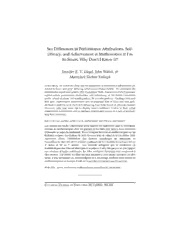
ERIC EJ728355: Sex Differences in Performance Attributions, Self-Efficacy, and Achievement in Mathematics: If I'm So Smart, Why Don't I Know It? PDF
Preview ERIC EJ728355: Sex Differences in Performance Attributions, Self-Efficacy, and Achievement in Mathematics: If I'm So Smart, Why Don't I Know It?
Sex(cid:561)Differences(cid:561)in(cid:561)Performance(cid:561)Attributions,(cid:561)Self(cid:556) Efficacy,(cid:561)and(cid:561)Achievement(cid:561)in(cid:561)Mathematics:(cid:561)If(cid:561)I’m(cid:561) So(cid:561)Smart,(cid:561)Why(cid:561)Don’t(cid:561)I(cid:561)Know(cid:561)It?(cid:561) (cid:561) Jennifer(cid:561)E.(cid:561)V.(cid:561)Lloyd,(cid:561)John(cid:561)Walsh,(cid:561)&(cid:561)(cid:561) Manizheh(cid:561)Shehni(cid:561)Yailagh(cid:561) (cid:561) In(cid:561)this(cid:561)study,(cid:561)we(cid:561)tested(cid:561)the(cid:561)claim(cid:561)that(cid:561)sex(cid:561)differences(cid:561)in(cid:561)mathematics(cid:561)achievement(cid:561)are(cid:561) related(cid:561)to(cid:561)boys’(cid:561)and(cid:561)girls’(cid:561)differing(cid:561)achievement(cid:556)related(cid:561)beliefs.(cid:561)(cid:561)We(cid:561)compared(cid:561)the(cid:561) mathematics(cid:561)report(cid:561)card(cid:561)grades,(cid:561)2001(cid:561)Foundation(cid:561)Skills(cid:561)Assessment(cid:561)(FSA)(cid:561)Numeracy(cid:561) subtest(cid:561)scores,(cid:561)performance(cid:561)attributions,(cid:561)and(cid:561)self(cid:556)efficacy(cid:561)of(cid:561)161(cid:561)British(cid:561)Columbian(cid:561) public(cid:561)school(cid:561)students’(cid:561)(62(cid:561)fourth(cid:556)graders,(cid:561)99(cid:561)seventh(cid:556)graders).(cid:561)(cid:561)Findings(cid:561)indicated(cid:561) that(cid:561)girls’(cid:561)mathematics(cid:561)achievement(cid:561)met(cid:561)or(cid:561)exceeded(cid:561)that(cid:561)of(cid:561)boys(cid:561)and(cid:561)that(cid:561)girls’(cid:561) attribution(cid:561)patterns(cid:561)were(cid:561)more(cid:561)self(cid:556)enhancing(cid:561)than(cid:561)those(cid:561)found(cid:561)in(cid:561)previous(cid:561)studies.(cid:561)(cid:561) However,(cid:561)girls(cid:561)were(cid:561)more(cid:561)apt(cid:561)to(cid:561)display(cid:561)under(cid:556)confidence(cid:561)relative(cid:561)to(cid:561)their(cid:561)actual(cid:561) mathematics(cid:561)achievement(cid:561)and(cid:561)to(cid:561)attribute(cid:561)mathematics(cid:561)failure(cid:561)to(cid:561)a(cid:561)lack(cid:561)of(cid:561)teachers’(cid:561) help(cid:561)than(cid:561)were(cid:561)boys.(cid:561) (cid:561) Keywords:(cid:561)sex,(cid:561)gender,(cid:561)achievement,(cid:561)mathematics,(cid:561)self(cid:556)efficacy,(cid:561)attributions(cid:561) Les(cid:561)auteurs(cid:561)ont(cid:561)étudié(cid:561)l’affirmation(cid:561)selon(cid:561)laquelle(cid:561)les(cid:561)différences(cid:561)dans(cid:561)le(cid:561)rendement(cid:561) scolaire(cid:561)en(cid:561)mathématiques(cid:561)chez(cid:561)les(cid:561)garçons(cid:561)et(cid:561)les(cid:561)filles(cid:561)sont(cid:561)liées(cid:561)à(cid:561)leurs(cid:561)croyances(cid:561) différentes(cid:561)au(cid:561)sujet(cid:561)du(cid:561)rendement.(cid:561)(cid:561)Ils(cid:561)ont(cid:561)comparé(cid:561)les(cid:561)notes(cid:561)en(cid:561)mathématiques(cid:561)sur(cid:561)les(cid:561) bulletins(cid:561)scolaires,(cid:561)les(cid:561)résultats(cid:561)de(cid:561)2001(cid:561)des(cid:561)sous(cid:556)tests(cid:561)de(cid:561)calcul(cid:561)de(cid:561)la(cid:561)Foundation(cid:561)Skills(cid:561) Assessment(cid:561) (FSA),(cid:561) l’attribution(cid:561) des(cid:561) facteurs(cid:561) contribuant(cid:561) au(cid:561) rendement(cid:561) et(cid:561) l’autoefficacité(cid:561)chez(cid:561)161(cid:561)élèves(cid:561)d’écoles(cid:561)publiques(cid:561)de(cid:561)la(cid:561)Colombie(cid:556)Britannique(cid:561)(62(cid:561)en(cid:561) 4e(cid:561) année(cid:561) et(cid:561) 99(cid:561) en(cid:561) 7e(cid:561) année).(cid:561) (cid:561) Les(cid:561) résultats(cid:561) indiquent(cid:561) que(cid:561) le(cid:561) rendement(cid:561) en(cid:561) mathématiques(cid:561)des(cid:561)filles(cid:561)est(cid:561)identique(cid:561)ou(cid:561)supérieur(cid:561)à(cid:561)celui(cid:561)des(cid:561)garçons(cid:561)et,(cid:561)par(cid:561)rapport(cid:561) aux(cid:561)résultats(cid:561)d’études(cid:561)antérieures,(cid:561)les(cid:561)filles(cid:561)attribuent(cid:561)davantage(cid:561)leur(cid:561)rendement(cid:561)à(cid:561) elles(cid:556)mêmes.(cid:561)(cid:561)Par(cid:561)contre,(cid:561)les(cid:561)filles(cid:561)ont(cid:561)plus(cid:561)tendance(cid:561)à(cid:561)avoir(cid:561)moins(cid:561)confiance(cid:561)en(cid:561)elles(cid:561) quant(cid:561)à(cid:561)leur(cid:561)rendement(cid:561)en(cid:561)mathématiques(cid:561)et(cid:561)à(cid:561)davantage(cid:561)attribuer(cid:561)leurs(cid:561)échecs(cid:561)en(cid:561) mathématiques(cid:561)à(cid:561)un(cid:561)manque(cid:561)d’aide(cid:561)de(cid:561)la(cid:561)part(cid:561)des(cid:561)enseignants(cid:561)que(cid:561)les(cid:561)garçons.(cid:561) (cid:561) Mots(cid:561)clés(cid:561):(cid:561)(cid:561)genre,(cid:561)rendement,(cid:561)mathématiques,(cid:561)autoefficacité,(cid:561)attribution.(cid:561) (cid:561) _________________ CANADIAN(cid:561)JOURNAL(cid:561)OF(cid:561)EDUCATION(cid:561)28,(cid:561)3(cid:561)(2005):(cid:561)384(cid:556)408(cid:561) SEX(cid:561)DIFFERENCES(cid:561)IN(cid:561)MATHEMATICS(cid:561) (cid:561) 385(cid:561) (cid:561) (cid:561) Sex(cid:561) differences(cid:561) in(cid:561) academic(cid:561) achievement(cid:561) have(cid:561) been(cid:561) the(cid:561) subject(cid:561) of(cid:561) extensive(cid:561)investigation(cid:561)over(cid:561)the(cid:561)past(cid:561)two(cid:561)decades(cid:561)(Fan(cid:561)&(cid:561)Chen,(cid:561)1997;(cid:561) Kianian,(cid:561)1996).(cid:561)Traditionally,(cid:561)studies(cid:561)have(cid:561)shown(cid:561)that(cid:561)boys’(cid:561)mathematics(cid:561) achievement(cid:561)is(cid:561)superior(cid:561)to(cid:561)that(cid:561)of(cid:561)girls(cid:561)(e.g.,(cid:561)Maccoby(cid:561)&(cid:561)Jacklin,(cid:561)1974).(cid:561) One(cid:561)explanation(cid:561)offered(cid:561)for(cid:561)this(cid:561)achievement(cid:561)gap(cid:561)is(cid:561)that(cid:561)there(cid:561)are(cid:561)sex(cid:561) differences(cid:561) in(cid:561) students’(cid:561) mathematics(cid:556)related(cid:561) beliefs(cid:561) (Bandura,(cid:561) 1997;(cid:561) Stipek(cid:561)&(cid:561)Gralinski,(cid:561)1991)(cid:561)and(cid:561)that,(cid:561)more(cid:561)specifically,(cid:561)boys’(cid:561)attribution(cid:561) patterns(cid:561)and(cid:561)levels(cid:561)of(cid:561)self(cid:556)efficacy(cid:561)are(cid:561)more(cid:561)self(cid:556)enhancing(cid:561)than(cid:561)those(cid:561)of(cid:561) girls.(cid:561) (cid:561) In(cid:561)the(cid:561)past(cid:561)decade,(cid:561)there(cid:561)has(cid:561)been(cid:561)a(cid:561)closing(cid:561)in(cid:561)this(cid:561)mathematics(cid:561) achievement(cid:561)gap.(cid:561)In(cid:561)British(cid:561)Columbia,(cid:561)for(cid:561)example,(cid:561)data(cid:561)from(cid:561)a(cid:561)recent(cid:561) Foundation(cid:561)Skills(cid:561)Assessment(cid:561)(FSA)(cid:561)show(cid:561)only(cid:561)negligible(cid:561)sex(cid:561)differences(cid:561) in(cid:561)performance(cid:561)on(cid:561)the(cid:561)Numeracy(cid:561)subtest(cid:561)(British(cid:561)Columbia(cid:561)Ministry(cid:561)of(cid:561) Education,(cid:561)2002).(cid:561)(cid:561) (cid:561) In(cid:561)our(cid:561)study,(cid:561)we(cid:561)posited(cid:561)that,(cid:561)if(cid:561)achievement(cid:561)differences(cid:561)are(cid:561)indeed(cid:561) related(cid:561)to(cid:561)students’(cid:561)self(cid:556)efficacy(cid:561)and(cid:561)attributions,(cid:561)then(cid:561)boys’(cid:561)and(cid:561)girls’(cid:561) achievement(cid:556)related(cid:561)beliefs(cid:561)should(cid:561)be(cid:561)the(cid:561)same(cid:561)when(cid:561)their(cid:561)academic(cid:561) achievement(cid:561)is(cid:561)also(cid:561)the(cid:561)same.(cid:561)Therefore,(cid:561)we(cid:561)designed(cid:561)this(cid:561)study(cid:561)to(cid:561) determine(cid:561)if(cid:561)the(cid:561)recent(cid:561)academic(cid:561)gains(cid:561)of(cid:561)girls(cid:561)in(cid:561)mathematics(cid:561)have(cid:561)been(cid:561) met(cid:561) with(cid:561) heightened(cid:561) perceptions(cid:561) of(cid:561) self(cid:556)efficacy(cid:561) and(cid:561) more(cid:561) self(cid:556) enhancing(cid:561)performance(cid:561)attributions.(cid:561)(cid:561) (cid:561) We(cid:561)argue(cid:561)that,(cid:561)as(cid:561)a(cid:561)practical(cid:561)matter,(cid:561)achievement(cid:561)gains(cid:561)are(cid:561)insufficient(cid:561) unless(cid:561)the(cid:561)self(cid:556)beliefs(cid:561)of(cid:561)girls(cid:561)have(cid:561)changed(cid:561)correspondingly.(cid:561)According(cid:561) to(cid:561)Pajares(cid:561)(1996),(cid:561)an(cid:561)underestimation(cid:561)of(cid:561)mathematics(cid:561)capability,(cid:561)not(cid:561)lack(cid:561) of(cid:561)skill,(cid:561)is(cid:561)responsible(cid:561)for(cid:561)students’(cid:561)avoidance(cid:561)of(cid:561)mathematics(cid:561)courses(cid:561) and(cid:561)careers,(cid:561)and(cid:561)that(cid:561)this(cid:561)is(cid:561)more(cid:561)likely(cid:561)to(cid:561)be(cid:561)the(cid:561)case(cid:561)with(cid:561)females(cid:561)than(cid:561) with(cid:561)males.(cid:561)(cid:561) (cid:561) Now,(cid:561)more(cid:561)than(cid:561)ever(cid:561)before,(cid:561)mathematics(cid:561)competency(cid:561)is(cid:561)essential(cid:561)for(cid:561) advancement(cid:561)into(cid:561)a(cid:561)breadth(cid:561)of(cid:561)post(cid:556)secondary(cid:561)programs(cid:561)and(cid:561)careers(cid:561) (Sukthankar,(cid:561) 1999).(cid:561) Furthermore,(cid:561) Eccles(cid:561) (1987)(cid:561) found(cid:561) that(cid:561) persons(cid:561) employed(cid:561)in(cid:561)mathematics(cid:556)(cid:561)or(cid:561)science(cid:556)related(cid:561)careers(cid:561)tend(cid:561)to(cid:561)gain(cid:561)more(cid:561) autonomy,(cid:561)higher(cid:561)prestige,(cid:561)and(cid:561)higher(cid:561)pay(cid:561)than(cid:561)do(cid:561)persons(cid:561)in(cid:561)other(cid:561) career(cid:561)domains.(cid:561)As(cid:561)such,(cid:561)research(cid:561)focussed(cid:561)on(cid:561)understanding(cid:561)to(cid:561)a(cid:561)fuller(cid:561) extent(cid:561)students’(cid:561)performance(cid:561)in(cid:561)and(cid:561)beliefs(cid:561)about(cid:561)mathematics(cid:561)is(cid:561)timely(cid:561) and(cid:561)vital.(cid:561) 386(cid:561)(cid:561)(cid:561)(cid:561)(cid:561)(cid:561)(cid:561)(cid:561)(cid:561)(cid:561)(cid:561)(cid:561)(cid:561)(cid:561)(cid:561)(cid:561)(cid:561)(cid:561)(cid:561)(cid:561)(cid:561)(cid:561)(cid:561)(cid:561)(cid:561)(cid:561)(cid:561)JENNIFER(cid:561)E.V.(cid:561)LLOYD,(cid:561)JOHN(cid:561)WALSH,(cid:561)&(cid:561)MANIZHEH(cid:561)SHEHNI(cid:561)YAILUGH(cid:561)(cid:561) Attributions(cid:561) The(cid:561)inferences(cid:561)that(cid:561)individuals(cid:561)make(cid:561)about(cid:561)the(cid:561)causes(cid:561)of(cid:561)their(cid:561)successes(cid:561) and(cid:561)failures(cid:561)are(cid:561)called(cid:561)attributions(cid:561)(Graham,(cid:561)1991;(cid:561)Weiner,(cid:561)1986).(cid:561)When(cid:561) asked(cid:561)to(cid:561)give(cid:561)the(cid:561)subjective(cid:561)reasons(cid:561)for(cid:561)their(cid:561)academic(cid:561)performance,(cid:561) whether(cid:561) good(cid:561) or(cid:561) bad,(cid:561) students(cid:561) tend(cid:561) to(cid:561) pinpoint(cid:561) factors(cid:561) within(cid:561) themselves(cid:561)(e.g.,(cid:561)ability,(cid:561)effort,(cid:561)traits,(cid:561)and(cid:561)dispositions)(cid:561)or(cid:561)factors(cid:561)outside(cid:561) of(cid:561)themselves(cid:561)(e.g.,(cid:561)luck,(cid:561)ease(cid:561)or(cid:561)difficulty(cid:561)of(cid:561)the(cid:561)task,(cid:561)and(cid:561)help(cid:561)from(cid:561) teacher).(cid:561)An(cid:561)attribution(cid:561)pattern(cid:561)in(cid:561)which(cid:561)a(cid:561)student(cid:561)internalises(cid:561)success(cid:561) and(cid:561) externalises(cid:561) failure(cid:561) has(cid:561) long(cid:561) been(cid:561) thought(cid:561) to(cid:561) be(cid:561) beneficial(cid:561) academically(cid:561)and(cid:561)important(cid:561)in(cid:561)explaining(cid:561)success(cid:561)(Schunk(cid:561)&(cid:561)Gunn,(cid:561) 1986).(cid:561)Although(cid:561)ability(cid:561)and(cid:561)effort(cid:561)are(cid:561)both(cid:561)internal(cid:561)attributions,(cid:561)it(cid:561)is(cid:561) better(cid:561)for(cid:561)an(cid:561)individual(cid:561)to(cid:561)attribute(cid:561)success(cid:561)to(cid:561)ability,(cid:561)rather(cid:561)than(cid:561)to(cid:561) effort,(cid:561) because(cid:561) ability(cid:561) attributions(cid:561) are(cid:561) more(cid:561) strongly(cid:561) related(cid:561) to(cid:561) motivation,(cid:561) self(cid:556)efficacy,(cid:561) and(cid:561) skill(cid:561) development(cid:561) than(cid:561) are(cid:561) effort(cid:561) attributions(cid:561)(Schunk(cid:561)&(cid:561)Gunn,(cid:561)1986).(cid:561)Similarly,(cid:561)Graham(cid:561)(1991)(cid:561)suggests(cid:561) that(cid:561)students(cid:561)benefit(cid:561)more(cid:561)from(cid:561)attributing(cid:561)academic(cid:561)failure(cid:561)to(cid:561)a(cid:561)lack(cid:561)of(cid:561) effort(cid:561)rather(cid:561)than(cid:561)to(cid:561)a(cid:561)lack(cid:561)of(cid:561)ability.(cid:561)(cid:561) (cid:561) Much(cid:561)of(cid:561)the(cid:561)attribution(cid:561)literature(cid:561)involves(cid:561)an(cid:561)examination(cid:561)of(cid:561)the(cid:561) relationship(cid:561)between(cid:561)students’(cid:561)attributions(cid:561)and(cid:561)their(cid:561)achievement(cid:561)in(cid:561) mathematics.(cid:561)For(cid:561)example,(cid:561)Georgiou(cid:561)(1999)(cid:561)explored(cid:561)the(cid:561)relationship(cid:561) between(cid:561) sixth(cid:556)grade(cid:561) students’(cid:561) performance(cid:561) attributions(cid:561) and(cid:561) their(cid:561) achievement(cid:561)in(cid:561)mathematics.(cid:561)He(cid:561)found(cid:561)that(cid:561)children’s(cid:561)attributions(cid:561)to(cid:561) effort,(cid:561)to(cid:561)ability,(cid:561)and(cid:561)to(cid:561)other(cid:561)internal(cid:561)factors(cid:561)were(cid:561)related(cid:561)positively(cid:561)to(cid:561) academic(cid:561) achievement,(cid:561) whereas(cid:561) attributions(cid:561) to(cid:561) luck(cid:561) and(cid:561) to(cid:561) external(cid:561) factors(cid:561)were(cid:561)related(cid:561)negatively(cid:561)to(cid:561)achievement.(cid:561)Schunk(cid:561)and(cid:561)Gunn(cid:561)(1986)(cid:561) investigated(cid:561) how(cid:561) task(cid:561) strategies(cid:561) and(cid:561) success(cid:561) attributions(cid:561) during(cid:561) mathematics(cid:561)training(cid:561)were(cid:561)related(cid:561)to(cid:561)students’(cid:561)perceptions(cid:561)of(cid:561)efficacy(cid:561) and(cid:561) to(cid:561) their(cid:561) skills.(cid:561) Participants(cid:561) lacking(cid:561) division(cid:561) skills(cid:561) were(cid:561) given(cid:561) assistance(cid:561) in(cid:561) solving(cid:561) problems.(cid:561) Results(cid:561) revealed(cid:561) that(cid:561) children(cid:561) who(cid:561) attributed(cid:561)their(cid:561)problem(cid:556)solving(cid:561)success(cid:561)to(cid:561)ability(cid:561)showed(cid:561)enhanced(cid:561) perceptions(cid:561)of(cid:561)self(cid:556)efficacy.(cid:561)These(cid:561)perceptions(cid:561)of(cid:561)self(cid:556)efficacy,(cid:561)in(cid:561)turn,(cid:561) related(cid:561)to(cid:561)higher(cid:561)mathematics(cid:561)achievement.(cid:561)(cid:561) (cid:561) Research(cid:561) suggests(cid:561) that(cid:561) girls(cid:561) tend(cid:561) to(cid:561) attribute(cid:561) their(cid:561) mathematics(cid:561) successes(cid:561)to(cid:561)external(cid:561)factors(cid:561)and(cid:561)to(cid:561)effort(cid:561)and(cid:561)their(cid:561)failures(cid:561)to(cid:561)their(cid:561)own(cid:561) lack(cid:561)of(cid:561)ability(cid:561)(a(cid:561)self(cid:556)defeating(cid:561)attribution(cid:561)pattern),(cid:561)whereas(cid:561)boys(cid:561)tend(cid:561)to(cid:561) SEX(cid:561)DIFFERENCES(cid:561)IN(cid:561)MATHEMATICS(cid:561) (cid:561) 387(cid:561) (cid:561) (cid:561) ascribe(cid:561)the(cid:561)causes(cid:561)of(cid:561)their(cid:561)mathematics(cid:561)successes(cid:561)to(cid:561)internal(cid:561)factors(cid:561)and(cid:561) their(cid:561)failures(cid:561)to(cid:561)external(cid:561)factors(cid:561)(a(cid:561)self(cid:556)enhancing(cid:561)attribution(cid:561)pattern).(cid:561) These(cid:561) patterns(cid:561) have(cid:561) explained,(cid:561) in(cid:561) part,(cid:561) girls’(cid:561) traditionally(cid:561) poorer(cid:561) mathematics(cid:561) achievement(cid:561) compared(cid:561) to(cid:561) that(cid:561) of(cid:561) boys.(cid:561) For(cid:561) example,(cid:561) Campbell(cid:561)and(cid:561)Hackett(cid:561)(1986)(cid:561)investigated(cid:561)sex(cid:561)differences(cid:561)in(cid:561)mathematics(cid:561) performance(cid:561)attributions(cid:561)and(cid:561)found(cid:561)that(cid:561)successful(cid:561)females(cid:561)rated(cid:561)“being(cid:561) lucky”(cid:561) (an(cid:561) external(cid:561) attribution)(cid:561) as(cid:561) the(cid:561) cause(cid:561) of(cid:561) their(cid:561) performance(cid:561) significantly(cid:561)more(cid:561)often(cid:561)than(cid:561)did(cid:561)males.(cid:561)(cid:561) Self(cid:556)Efficacy(cid:561) In(cid:561)addition(cid:561)to(cid:561)sex(cid:561)differences(cid:561)in(cid:561)attribution(cid:561)patterns,(cid:561)researchers(cid:561)have(cid:561) related(cid:561)the(cid:561)mathematics(cid:561)achievement(cid:561)gap(cid:561)between(cid:561)the(cid:561)sexes(cid:561)to(cid:561)boys’(cid:561)and(cid:561) girls’(cid:561) differing(cid:561) perceptions(cid:561) of(cid:561) their(cid:561) abilities.(cid:561) Self(cid:556)efficacy(cid:561) refers(cid:561) to(cid:561) judgements(cid:561)individuals(cid:561)make(cid:561)about(cid:561)their(cid:561)abilities(cid:561)to(cid:561)perform(cid:561)behaviours(cid:561) at(cid:561)a(cid:561)certain(cid:561)level(cid:561)(Bandura,(cid:561)1997;(cid:561)Schunk,(cid:561)1984).(cid:561)The(cid:561)perceptions(cid:561)students(cid:561) hold(cid:561)about(cid:561)themselves,(cid:561)and(cid:561)about(cid:561)their(cid:561)academic(cid:561)competence,(cid:561)help(cid:561)to(cid:561) determine(cid:561)what(cid:561)they(cid:561)do(cid:561)with(cid:561)the(cid:561)knowledge(cid:561)and(cid:561)skills(cid:561)they(cid:561)possess(cid:561) (Pajares(cid:561)&(cid:561)Valiante,(cid:561)1999),(cid:561)and(cid:561)influence(cid:561)their(cid:561)choice(cid:561)of(cid:561)activities,(cid:561)effort(cid:561) expended,(cid:561)task(cid:561)persistence,(cid:561)and(cid:561)task(cid:561)accomplishments(cid:561)(Schunk(cid:561)&(cid:561)Gunn,(cid:561) 1986).(cid:561)(cid:561) (cid:561) Much(cid:561) of(cid:561) the(cid:561) self(cid:556)efficacy(cid:561) literature(cid:561) examines(cid:561) specifically(cid:561) the(cid:561) relationship(cid:561)between(cid:561)students’(cid:561)self(cid:556)efficacy(cid:561)and(cid:561)their(cid:561)achievement(cid:561)in(cid:561) mathematics.(cid:561) Hackett(cid:561) and(cid:561) Betz(cid:561) (1989),(cid:561) for(cid:561) instance,(cid:561) explored(cid:561) the(cid:561) relationship(cid:561)between(cid:561)college(cid:561)students’(cid:561)mathematics(cid:561)achievement(cid:561)and(cid:561) mathematics(cid:561)self(cid:556)efficacy,(cid:561)their(cid:561)attitudes(cid:561)towards(cid:561)mathematics,(cid:561)and(cid:561)their(cid:561) choice(cid:561) of(cid:561) mathematics(cid:556)related(cid:561) degree(cid:561) programs.(cid:561) They(cid:561) discovered(cid:561) positive(cid:561) correlations(cid:561) among(cid:561) students’(cid:561) mathematics(cid:561) achievement(cid:561) and(cid:561) their(cid:561)levels(cid:561)of(cid:561)self(cid:556)efficacy,(cid:561)mathematics(cid:561)attitudes,(cid:561)and(cid:561)their(cid:561)masculine(cid:561) sex(cid:556)role(cid:561)orientation.(cid:561)Lent,(cid:561)Lopez,(cid:561)and(cid:561)Bieschke(cid:561)(1993)(cid:561)investigated(cid:561)the(cid:561) relationships(cid:561) among(cid:561) students’(cid:561) prior(cid:561) mathematics(cid:561) achievement,(cid:561) mathematics(cid:561)self(cid:556)efficacy,(cid:561)outcome(cid:561)expectations,(cid:561)and(cid:561)students’(cid:561)interests.(cid:561) Their(cid:561) findings(cid:561) indicated(cid:561) that(cid:561) participants’(cid:561) mathematics(cid:561) self(cid:556)efficacy(cid:561) related(cid:561)positively(cid:561)to(cid:561)their(cid:561)interest(cid:561)in(cid:561)mathematics(cid:561)and(cid:561)science,(cid:561)to(cid:561)their(cid:561) selection(cid:561)of(cid:561)science(cid:556)based(cid:561)degree(cid:561)programs(cid:561)and(cid:561)career(cid:561)choices,(cid:561)and(cid:561)to(cid:561) their(cid:561)performance(cid:561)in(cid:561)mathematics.(cid:561)Matsui,(cid:561)Matsui,(cid:561)and(cid:561)Ohnishi(cid:561)(1990)(cid:561) 388(cid:561)(cid:561)(cid:561)(cid:561)(cid:561)(cid:561)(cid:561)(cid:561)(cid:561)(cid:561)(cid:561)(cid:561)(cid:561)(cid:561)(cid:561)(cid:561)(cid:561)(cid:561)(cid:561)(cid:561)(cid:561)(cid:561)(cid:561)(cid:561)(cid:561)(cid:561)(cid:561)JENNIFER(cid:561)E.V.(cid:561)LLOYD,(cid:561)JOHN(cid:561)WALSH,(cid:561)&(cid:561)MANIZHEH(cid:561)SHEHNI(cid:561)YAILUGH(cid:561)(cid:561) explored(cid:561) the(cid:561) mechanisms(cid:561) underlying(cid:561) mathematics(cid:561) self(cid:556)efficacy(cid:561) in(cid:561) Japanese(cid:561) college(cid:561) students.(cid:561) They(cid:561) found(cid:561) that(cid:561) students(cid:561) with(cid:561) high(cid:561) frequencies(cid:561)of(cid:561)mathematics(cid:561)accomplishment(cid:561)also(cid:561)had(cid:561)higher(cid:561)levels(cid:561)of(cid:561) mathematics(cid:561) self(cid:556)efficacy(cid:561) than(cid:561) did(cid:561) students(cid:561) with(cid:561) fewer(cid:561) accomplishments.(cid:561)They(cid:561)also(cid:561)found(cid:561)that(cid:561)males’(cid:561)mathematics(cid:561)self(cid:556)efficacy(cid:561) was(cid:561)significantly(cid:561)higher(cid:561)than(cid:561)that(cid:561)of(cid:561)females.(cid:561) (cid:561) Much(cid:561) of(cid:561) the(cid:561) related(cid:561) literature(cid:561) reveals(cid:561) differences(cid:561) in(cid:561) males’(cid:561) and(cid:561) females’(cid:561) perceptions(cid:561) of(cid:561) mathematics(cid:561) efficacy,(cid:561) suggesting(cid:561) that(cid:561) these(cid:561) different(cid:561) perceptions(cid:561) relate(cid:561) to(cid:561) girls’(cid:561) relatively(cid:561) lower(cid:561) mathematics(cid:561) performance(cid:561) and(cid:561) lower(cid:561) participation(cid:561) rates(cid:561) in(cid:561) mathematics(cid:556)related(cid:561) careers(cid:561)(Eccles,(cid:561)1987).(cid:561)For(cid:561)example,(cid:561)Malpass,(cid:561)O’Neil,(cid:561)and(cid:561)Hocevar(cid:561)(1999)(cid:561) investigated(cid:561) the(cid:561) effects(cid:561) of(cid:561) sex(cid:561) and(cid:561) of(cid:561) self(cid:556)efficacy(cid:561) on(cid:561) mathematics(cid:561) achievement(cid:561)in(cid:561)a(cid:561)sample(cid:561)of(cid:561)gifted(cid:561)high(cid:556)school(cid:561)students.(cid:561)Results(cid:561)showed(cid:561) that(cid:561)self(cid:556)efficacy(cid:561)related(cid:561)positively(cid:561)to(cid:561)achievement(cid:561)and(cid:561)that(cid:561)males(cid:561)had(cid:561) enhanced(cid:561) perceptions(cid:561) of(cid:561) mathematics(cid:561) self(cid:556)efficacy(cid:561) than(cid:561) did(cid:561) females.(cid:561) Junge(cid:561) and(cid:561) Dretzke(cid:561) (1995)(cid:561) examined(cid:561) the(cid:561) relationship(cid:561) between(cid:561) gifted(cid:561) students’(cid:561)self(cid:556)efficacy(cid:561)and(cid:561)their(cid:561)mathematics(cid:561)behaviours(cid:561)and(cid:561)determined(cid:561) that,(cid:561)generally,(cid:561)boys(cid:561)had(cid:561)more(cid:561)enhanced(cid:561)perceptions(cid:561)of(cid:561)self(cid:556)efficacy(cid:561)than(cid:561) did(cid:561)girls.(cid:561)Pajares(cid:561)and(cid:561)Miller(cid:561)(1994)(cid:561)explored(cid:561)the(cid:561)role(cid:561)of(cid:561)self(cid:556)efficacy(cid:561)in(cid:561) mathematical(cid:561)problem(cid:561)solving(cid:561)and(cid:561)found(cid:561)that(cid:561)mathematics(cid:561)self(cid:556)efficacy(cid:561) was(cid:561)more(cid:561)predictive(cid:561)of(cid:561)problem(cid:561)solving(cid:561)than(cid:561)was(cid:561)mathematics(cid:561)self(cid:556) concept,(cid:561) perceived(cid:561)usefulness(cid:561) of(cid:561) mathematics,(cid:561) prior(cid:561) experience(cid:561) with(cid:561) mathematics,(cid:561)or(cid:561)students’(cid:561)sex.(cid:561)(cid:561) METHOD(cid:561) Participants(cid:561) One(cid:561)hundred(cid:561)sixty(cid:556)one(cid:561)students(cid:561)consented(cid:561)to(cid:561)participate(cid:561)in(cid:561)the(cid:561)study:(cid:561)62(cid:561) fourth(cid:556)graders(cid:561)(37(cid:561)male,(cid:561)25(cid:561)female)(cid:561)and(cid:561)99(cid:561)seventh(cid:556)graders(cid:561)(43(cid:561)male,(cid:561)56(cid:561) female).(cid:561)The(cid:561)mean(cid:561)age(cid:561)of(cid:561)fourth(cid:556)grade(cid:561)participants(cid:561)was(cid:561)9.32(cid:561)years(cid:561)(SD(cid:561)=(cid:561) 0.50,(cid:561)range(cid:561)8(cid:561)to(cid:561)10(cid:561)years)(cid:561)and(cid:561)12.27(cid:561)years(cid:561)for(cid:561)seventh(cid:556)graders(cid:561)(SD(cid:561)=(cid:561)0.45,(cid:561) range(cid:561)12(cid:561)to(cid:561)13(cid:561)years).(cid:561)Fourth(cid:556)grade(cid:561)participants(cid:561)were(cid:561)drawn(cid:561)from(cid:561)five(cid:561) public(cid:561)elementary(cid:561)schools,(cid:561)and(cid:561)seventh(cid:556)grade(cid:561)participants(cid:561)were(cid:561)drawn(cid:561) from(cid:561)two(cid:561)public(cid:561)middle(cid:561)schools.(cid:561)All(cid:561)schools(cid:561)were(cid:561)situated(cid:561)in(cid:561)one(cid:561)school(cid:561) district(cid:561)in(cid:561)a(cid:561)suburban(cid:561)area(cid:561)of(cid:561)a(cid:561)moderate(cid:556)sized(cid:561)city(cid:561)in(cid:561)British(cid:561)Columbia.(cid:561)(cid:561) SEX(cid:561)DIFFERENCES(cid:561)IN(cid:561)MATHEMATICS(cid:561) (cid:561) 389(cid:561) (cid:561) (cid:561) Instruments(cid:561)(cid:561) Foundation(cid:561)Skills(cid:561)Assessment(cid:561)(FSA)(cid:561)Numeracy(cid:561)subtest(cid:561)scores.(cid:561)Participants’(cid:561) 2001(cid:561) FSA(cid:561) Numeracy(cid:561) subtest(cid:561) standardised(cid:561) scores(cid:561) served(cid:561) as(cid:561) the(cid:561) first(cid:561) measure(cid:561) of(cid:561) mathematics(cid:556)related(cid:561) achievement.(cid:561) The(cid:561) BC(cid:561) Ministry(cid:561) of(cid:561) Education’s(cid:561) FSA(cid:561) is(cid:561) a(cid:561) three(cid:556)part(cid:561) annual(cid:561) assessment(cid:561) test(cid:561) designed(cid:561) to(cid:561) measure(cid:561)the(cid:561)reading(cid:561)comprehension,(cid:561)writing,(cid:561)and(cid:561)numeracy(cid:561)skills(cid:561)of(cid:561) fourth(cid:556),(cid:561) seventh(cid:556),(cid:561) and(cid:561) tenth(cid:556)grade(cid:561) students1(cid:561) throughout(cid:561) British(cid:561) Columbia.(cid:561)The(cid:561)FSA(cid:561)reflects(cid:561)what(cid:561)students(cid:561)learn(cid:561)in(cid:561)the(cid:561)classrooms(cid:561)in(cid:561)two(cid:561) important(cid:561)ways.(cid:561)First,(cid:561)it(cid:561)measures:(cid:561) foundation(cid:561)skills(cid:561)that(cid:561)are(cid:561)part(cid:561)of(cid:561)the(cid:561)provincial(cid:561)curriculum.(cid:561)FSA(cid:561)represents(cid:561)broad(cid:561) skills(cid:561)that(cid:561)all(cid:561)students(cid:561)are(cid:561)expected(cid:561)to(cid:561)master.(cid:561)FSA(cid:561)only(cid:561)addresses(cid:561)skills(cid:561)that(cid:561)can(cid:561)be(cid:561) tested(cid:561)in(cid:561)a(cid:561)limited(cid:561)amount(cid:561)of(cid:561)time,(cid:561)using(cid:561)a(cid:561)pen(cid:556)and(cid:556)paper(cid:561)format.(cid:561)FSA(cid:561)does(cid:561)not(cid:561) measure(cid:561)specific(cid:561)subject(cid:561)knowledge(cid:561)or(cid:561)many(cid:561)of(cid:561)the(cid:561)more(cid:561)complex,(cid:561)integrated(cid:561)areas(cid:561)of(cid:561) learning(cid:561)(British(cid:561)Columbia(cid:561)Ministry(cid:561)of(cid:561)Education,(cid:561)2001,(cid:561)p.(cid:561)4,(cid:561)Pull(cid:556)Out(cid:561)Section).(cid:561) (cid:561) Second,(cid:561)the(cid:561)FSA(cid:561)tests(cid:561)are(cid:561)designed(cid:561)to(cid:561)measure(cid:561)cumulative(cid:561)learning.(cid:561) When(cid:561)fourth(cid:556)graders(cid:561)complete(cid:561)the(cid:561)assessment,(cid:561)they(cid:561)are(cid:561)expected(cid:561)to(cid:561) implement(cid:561)skills(cid:561)they(cid:561)have(cid:561)gained(cid:561)from(cid:561)kindergarten(cid:561)to(cid:561)the(cid:561)spring(cid:561)of(cid:561) grade(cid:561)4;(cid:561)when(cid:561)seventh(cid:556)grade(cid:561)students(cid:561)complete(cid:561)the(cid:561)version(cid:561)of(cid:561)the(cid:561)FSA,(cid:561) they(cid:561)are(cid:561)expected(cid:561)to(cid:561)use(cid:561)skills(cid:561)gained(cid:561)from(cid:561)kindergarten(cid:561)to(cid:561)grade(cid:561)7(cid:561) (British(cid:561)Columbia(cid:561)Ministry(cid:561)of(cid:561)Education,(cid:561)2001).(cid:561) (cid:561) According(cid:561) to(cid:561) the(cid:561) British(cid:561) Columbia(cid:561) Ministry(cid:561) of(cid:561) Education(cid:561) (2001)(cid:561) numeracy(cid:561) refers(cid:561) to(cid:561) the(cid:561) “combination(cid:561) of(cid:561) mathematical(cid:561) knowledge,(cid:561) problem(cid:561)solving(cid:561)and(cid:561)communication(cid:561)skills(cid:561)required(cid:561)by(cid:561)all(cid:561)persons(cid:561)to(cid:561) function(cid:561)within(cid:561)our(cid:561)technological(cid:561)world(cid:561)[and](cid:561)is(cid:561)more(cid:561)than(cid:561)knowing(cid:561) about(cid:561)numbers(cid:561)and(cid:561)number(cid:561)operations”(cid:561)(p.(cid:561)41).(cid:561)Although(cid:561)numeracy(cid:561)and(cid:561) mathematics(cid:561)are(cid:561)not(cid:561)identical(cid:561)ideas,(cid:561)mathematics(cid:561)is(cid:561)the(cid:561)school(cid:561)subject(cid:561) most(cid:561) closely(cid:561) related(cid:561) to(cid:561) numeracy.(cid:561) The(cid:561) fourth(cid:556)(cid:561) and(cid:561) seventh(cid:556)grade(cid:561) versions(cid:561)of(cid:561)the(cid:561)2001(cid:561)FSA(cid:561)Numeracy(cid:561)subtest(cid:561)each(cid:561)contained(cid:561)32(cid:561)multiple(cid:556) choice(cid:561)questions,(cid:561)and(cid:561)four(cid:561)constructed(cid:561)response(cid:561)questions(cid:561)worth(cid:561)four(cid:561) points(cid:561)each.(cid:561)(cid:561) (cid:561) Mathematics(cid:561)report(cid:561)card(cid:561)grades.(cid:561)Participants’(cid:561)spring(cid:561)2001(cid:561)mathematics(cid:561) report(cid:561)card(cid:561)grades(cid:561)served(cid:561)as(cid:561)the(cid:561)second(cid:561)achievement(cid:561)measure.(cid:561)These(cid:561) grades(cid:561)reflect(cid:561)teachers’(cid:561)assessments(cid:561)of(cid:561)students’(cid:561)performance(cid:561)of(cid:561)the(cid:561)BC(cid:561) Ministry(cid:561)of(cid:561)Education’s(cid:561)grade(cid:556)4(cid:561)or(cid:561)grade(cid:556)7(cid:561)mathematics(cid:561)curriculum.(cid:561) 390(cid:561)(cid:561)(cid:561)(cid:561)(cid:561)(cid:561)(cid:561)(cid:561)(cid:561)(cid:561)(cid:561)(cid:561)(cid:561)(cid:561)(cid:561)(cid:561)(cid:561)(cid:561)(cid:561)(cid:561)(cid:561)(cid:561)(cid:561)(cid:561)(cid:561)(cid:561)(cid:561)JENNIFER(cid:561)E.V.(cid:561)LLOYD,(cid:561)JOHN(cid:561)WALSH,(cid:561)&(cid:561)MANIZHEH(cid:561)SHEHNI(cid:561)YAILUGH(cid:561)(cid:561) Teachers(cid:561) and(cid:561) school(cid:561) secretaries(cid:561) provided(cid:561) us(cid:561) with(cid:561) each(cid:561) participant’s(cid:561) report(cid:561) card(cid:561) grade(cid:561) in(cid:561) percentage(cid:561) form.(cid:561) The(cid:561) Ministry(cid:561) of(cid:561) Education’s(cid:561) descriptions(cid:561)of(cid:561)report(cid:561)card(cid:561)achievement(cid:561)levels(cid:561)are(cid:561)presented(cid:561)in(cid:561)Table(cid:561)1.(cid:561)(cid:561) TABLE(cid:561)1(cid:561) Description(cid:561)of(cid:561)the(cid:561)British(cid:561)Columbia(cid:561)Ministry(cid:561)of(cid:561)Education’s(cid:561)Report(cid:561)Card(cid:561)Achievement(cid:561)Levels(cid:561) Achievement(cid:561)level(cid:561) Letter(cid:561)grade(cid:561) Description(cid:561) 86(cid:556)100%(cid:561) A(cid:561) Excellent(cid:561) 73(cid:556)85%(cid:561) B(cid:561) Very(cid:561)good(cid:561) 67(cid:556)72%(cid:561) C+(cid:561) Good(cid:561) 60(cid:556)66%(cid:561) C(cid:561) Satisfactory(cid:561) 50(cid:556)59%(cid:561) C(cid:556)(cid:561) Minimally(cid:561)acceptable(cid:561) 0(cid:556)49%(cid:561) F(cid:561) Below(cid:561)minimally(cid:561)acceptable(cid:561) (cid:561) (cid:561) (cid:561) Attribution(cid:561)scale.(cid:561)A(cid:561)modification(cid:561)of(cid:561)Stipek’s(cid:561)(1993)(cid:561)attribution(cid:561)scale,(cid:561)the(cid:561) first(cid:561)half(cid:561)of(cid:561)our(cid:561)attribution(cid:561)scale(cid:561)contained(cid:561)a(cid:561)list(cid:561)of(cid:561)six(cid:561)attributions(cid:561)given(cid:561) commonly(cid:561) by(cid:561) students(cid:561) in(cid:561) explaining(cid:561) their(cid:561) academic(cid:561) success:(cid:561) three(cid:561) internal(cid:561)attributions(cid:561)(“I(cid:561)studied(cid:561)hard”;(cid:561)“I(cid:561)studied(cid:561)the(cid:561)right(cid:561)things”;(cid:561)and(cid:561) “I(cid:561)am(cid:561)smart”)(cid:561)and(cid:561)three(cid:561)external(cid:561)attributions(cid:561)(“the(cid:561)teacher(cid:561)explained(cid:561) things(cid:561)well”;(cid:561)“someone(cid:561)helped(cid:561)me”;(cid:561)and(cid:561)“the(cid:561)work(cid:561)was(cid:561)easy”).(cid:561)The(cid:561) second(cid:561) half(cid:561) of(cid:561) the(cid:561) scale(cid:561) contained(cid:561) six(cid:561) attributions(cid:561) often(cid:561) offered(cid:561) for(cid:561) academic(cid:561)failure:(cid:561)three(cid:561)internal(cid:561)attributions(cid:561)(“I(cid:561)didn’t(cid:561)study(cid:561)enough”;(cid:561)“I(cid:561) studied(cid:561)the(cid:561)wrong(cid:561)things”;(cid:561)and(cid:561)“I(cid:561)don’t(cid:561)think(cid:561)I(cid:561)am(cid:561)smart”)(cid:561)and(cid:561)three(cid:561) external(cid:561)attributions(cid:561)(“the(cid:561)teacher(cid:561)explained(cid:561)things(cid:561)poorly”;(cid:561)“no(cid:561)one(cid:561) helped(cid:561)me”;(cid:561)and(cid:561)“the(cid:561)work(cid:561)was(cid:561)hard”).(cid:561)The(cid:561)same(cid:561)scale(cid:561)was(cid:561)used(cid:561)for(cid:561) SEX(cid:561)DIFFERENCES(cid:561)IN(cid:561)MATHEMATICS(cid:561) (cid:561) 391(cid:561) (cid:561) (cid:561) both(cid:561)grades.(cid:561) (cid:561) Self(cid:556)efficacy(cid:561) scale.(cid:561) We(cid:561) designed(cid:561) two(cid:561) separate(cid:561) versions(cid:561) of(cid:561) the(cid:561) self(cid:556) efficacy(cid:561)scale:(cid:561)one(cid:561)for(cid:561)fourth(cid:556)graders(cid:561)and(cid:561)one(cid:561)for(cid:561)seventh(cid:556)graders.(cid:561)Both(cid:561) were(cid:561)designed(cid:561)according(cid:561)to(cid:561)Bandura’s(cid:561)(2001)(cid:561)specifications(cid:561)and(cid:561)included(cid:561) a(cid:561)booklet(cid:561)of(cid:561)nine(cid:561)numeracy(cid:561)questions(cid:561)equivalent(cid:561)in(cid:561)form(cid:561)and(cid:561)difficulty(cid:561)to(cid:561) items(cid:561)on(cid:561)the(cid:561)grade(cid:556)specific(cid:561)version(cid:561)of(cid:561)2001(cid:561)FSA(cid:561)Numeracy(cid:561)subtest.(cid:561)We(cid:561) drew(cid:561)the(cid:561)test(cid:561)items(cid:561)directly(cid:561)from(cid:561)the(cid:561)BC(cid:561)Ministry(cid:561)of(cid:561)Education’s(cid:561)web(cid:561) site,(cid:561)which(cid:561)contains(cid:561)sample(cid:561)FSA(cid:561)numeracy(cid:561)items(cid:561)for(cid:561)parents,(cid:561)students,(cid:561) and(cid:561)teachers.2(cid:561)We(cid:561)provided(cid:561)students(cid:561)with(cid:561)an(cid:561)answer(cid:561)sheet(cid:561)to(cid:561)report(cid:561)their(cid:561) perceived(cid:561)confidence(cid:561)according(cid:561)to(cid:561)each(cid:561)of(cid:561)the(cid:561)sample(cid:561)FSA(cid:561)items(cid:561)in(cid:561)their(cid:561) respective(cid:561)booklets.(cid:561)(cid:561) (cid:561) The(cid:561)proportions(cid:561)of(cid:561)self(cid:556)efficacy(cid:561)scale(cid:561)sample(cid:561)FSA(cid:561)items(cid:561)devoted(cid:561)to(cid:561) each(cid:561) of(cid:561) the(cid:561) four(cid:561) FSA(cid:561) numeracy(cid:561) categories(cid:561) (numbers,(cid:561) patterns(cid:561) and(cid:561) relationships,(cid:561) shape(cid:561) and(cid:561) space,(cid:561) and(cid:561) statistics(cid:561) and(cid:561) probability)(cid:561) were(cid:561) commensurate(cid:561)with(cid:561)the(cid:561)proportions(cid:561)of(cid:561)questions(cid:561)used(cid:561)on(cid:561)the(cid:561)2001(cid:561)FSA.(cid:561) We(cid:561)achieved(cid:561)this(cid:561)parity(cid:561)by(cid:561)designing(cid:561)the(cid:561)self(cid:556)efficacy(cid:561)scales(cid:561)according(cid:561)to(cid:561) the(cid:561) BC(cid:561) Ministry(cid:561) of(cid:561) Education’s(cid:561) 2001(cid:561) FSA(cid:561) Table(cid:561) of(cid:561) Numeracy(cid:561) Specifications,(cid:561) a(cid:561) document(cid:561) that(cid:561) details(cid:561) the(cid:561) proportion(cid:561) of(cid:561) test(cid:561) items(cid:561) devoted(cid:561)to(cid:561)each(cid:561)numeracy(cid:561)category.3(cid:561)The(cid:561)sample(cid:561)FSA(cid:561)items(cid:561)included(cid:561)in(cid:561) the(cid:561)self(cid:556)efficacy(cid:561)scales(cid:561)were(cid:561)not(cid:561)included(cid:561)in(cid:561)the(cid:561)2001(cid:561)FSA.(cid:561)(cid:561) Procedure(cid:561) We(cid:561)used(cid:561)approximately(cid:561)30(cid:561)minutes(cid:561)of(cid:561)class(cid:561)time(cid:561)to(cid:561)explain(cid:561)and(cid:561)to(cid:561) administer(cid:561)the(cid:561)attribution(cid:561)and(cid:561)self(cid:556)efficacy(cid:561)scales.(cid:561)(cid:561)Although(cid:561)all(cid:561)grade(cid:556) appropriate(cid:561) students(cid:561) in(cid:561) the(cid:561) relevant(cid:561) schools(cid:561) were(cid:561) approached(cid:561) for(cid:561) participation(cid:561)in(cid:561)the(cid:561)study,(cid:561)a(cid:561)very(cid:561)small(cid:561)number(cid:561)of(cid:561)students(cid:561)did(cid:561)not(cid:561) return(cid:561)consent(cid:561)forms(cid:561)and/or(cid:561)chose(cid:561)to(cid:561)not(cid:561)participate.(cid:561)Teachers(cid:561)asked(cid:561) these(cid:561)non(cid:556)participants(cid:561)to(cid:561)read(cid:561)novels(cid:561)or(cid:561)to(cid:561)draw(cid:561)silently(cid:561)at(cid:561)their(cid:561)desks(cid:561) while(cid:561)the(cid:561)participants(cid:561)filled(cid:561)out(cid:561)the(cid:561)questionnaires.(cid:561)(cid:561)(cid:561) (cid:561) Attribution(cid:561)scale.(cid:561)First,(cid:561)we(cid:561)asked(cid:561)participants(cid:561)to(cid:561)read(cid:561)over(cid:561)the(cid:561)list(cid:561)of(cid:561) success(cid:561)attributions(cid:561)and(cid:561)to(cid:561)indicate(cid:561)on(cid:561)a(cid:561)five(cid:556)point(cid:561)Likert(cid:556)type(cid:561)scale(cid:561)the(cid:561) degree(cid:561)to(cid:561)which(cid:561)each(cid:561)attribution(cid:561)would(cid:561)explain(cid:561)“strong”(cid:561)mathematics(cid:561) performance(cid:561)(1(cid:561)=(cid:561)“this(cid:561)is(cid:561)not(cid:561)why(cid:561)I(cid:561)did(cid:561)well”;(cid:561)3(cid:561)=(cid:561)“this(cid:561)is(cid:561)kind(cid:561)of(cid:561)why(cid:561)I(cid:561) did(cid:561)well”;(cid:561)5(cid:561)=(cid:561)“this(cid:561)is(cid:561)the(cid:561)most(cid:561)important(cid:561)reason(cid:561)why(cid:561)I(cid:561)did(cid:561)well”).(cid:561) Second,(cid:561) participants(cid:561) read(cid:561) over(cid:561) the(cid:561) list(cid:561) of(cid:561) failure(cid:561) attributions(cid:561) and(cid:561) 392(cid:561)(cid:561)(cid:561)(cid:561)(cid:561)(cid:561)(cid:561)(cid:561)(cid:561)(cid:561)(cid:561)(cid:561)(cid:561)(cid:561)(cid:561)(cid:561)(cid:561)(cid:561)(cid:561)(cid:561)(cid:561)(cid:561)(cid:561)(cid:561)(cid:561)(cid:561)(cid:561)JENNIFER(cid:561)E.V.(cid:561)LLOYD,(cid:561)JOHN(cid:561)WALSH,(cid:561)&(cid:561)MANIZHEH(cid:561)SHEHNI(cid:561)YAILUGH(cid:561)(cid:561) indicated(cid:561)the(cid:561)degree(cid:561)to(cid:561)which(cid:561)each(cid:561)attribution(cid:561)would(cid:561)explain(cid:561)“poor”(cid:561) mathematics(cid:561)performance,(cid:561)according(cid:561)to(cid:561)a(cid:561)similar(cid:561)scale(cid:561)(1(cid:561)=(cid:561)“this(cid:561)is(cid:561)not(cid:561) why(cid:561)I(cid:561)did(cid:561)poorly”;(cid:561)3(cid:561)=(cid:561)“this(cid:561)is(cid:561)kind(cid:561)of(cid:561)why(cid:561)I(cid:561)did(cid:561)poorly”;(cid:561)5(cid:561)=(cid:561)“this(cid:561)is(cid:561)the(cid:561) most(cid:561)important(cid:561)reason(cid:561)why(cid:561)I(cid:561)did(cid:561)poorly”).(cid:561) (cid:561) Self(cid:556)efficacy(cid:561)scale.(cid:561)We(cid:561)gave(cid:561)students(cid:561)20(cid:561)seconds(cid:561)to(cid:561)view(cid:561)the(cid:561)first(cid:561)of(cid:561)the(cid:561) self(cid:556)efficacy(cid:561)scale’s(cid:561)sample(cid:561)FSA(cid:561)items.(cid:561)After(cid:561)the(cid:561)time(cid:561)elapsed,(cid:561)we(cid:561)asked(cid:561) participants(cid:561)to(cid:561)indicate(cid:561)how(cid:561)confident(cid:561)they(cid:561)were(cid:561)that,(cid:561)if(cid:561)asked(cid:561)to(cid:561)actually(cid:561) complete(cid:561) the(cid:561) question,(cid:561) they(cid:561) could(cid:561) determine(cid:561) the(cid:561) correct(cid:561) answer.(cid:561) Participants(cid:561)rated(cid:561)their(cid:561)confidence(cid:561)according(cid:561)to(cid:561)a(cid:561)seven(cid:556)point(cid:561)Likert(cid:556)type(cid:561) scale(cid:561)(1(cid:561)=(cid:561)“not(cid:561)confident(cid:561)at(cid:561)all”;(cid:561)3(cid:561)=(cid:561)“not(cid:561)too(cid:561)confident”;(cid:561)5(cid:561)=(cid:561)“pretty(cid:561) confident”,(cid:561)7(cid:561)=(cid:561)“very(cid:561)confident”).(cid:561)This(cid:561)process(cid:561)continued(cid:561)for(cid:561)each(cid:561)of(cid:561)the(cid:561) nine(cid:561)scale(cid:561)items.(cid:561)We(cid:561)asked(cid:561)students(cid:561)to(cid:561)refrain(cid:561)from(cid:561)actually(cid:561)completing(cid:561) (i.e.,(cid:561)formulating(cid:561)an(cid:561)answer(cid:561)for)(cid:561)the(cid:561)sample(cid:561)FSA(cid:561)items(cid:561)included(cid:561)in(cid:561)the(cid:561) self(cid:556)efficacy(cid:561)scale(cid:561)because,(cid:561)according(cid:561)to(cid:561)Bandura(cid:561)(1986),(cid:561)individuals(cid:561)are(cid:561) more(cid:561)influenced(cid:561)by(cid:561)how(cid:561)they(cid:561)interpret(cid:561)a(cid:561)task,(cid:561)than(cid:561)by(cid:561)their(cid:561)actual(cid:561) achievement,(cid:561)in(cid:561)terms(cid:561)of(cid:561)self(cid:556)perceptions(cid:561)of(cid:561)competence.(cid:561) (cid:561) According(cid:561)to(cid:561)Pajares(cid:561)and(cid:561)Kranzler(cid:561)(1995),(cid:561)researchers(cid:561)must(cid:561)administer(cid:561) self(cid:556)efficacy(cid:561)scales(cid:561)as(cid:561)closely(cid:561)as(cid:561)possible(cid:561)in(cid:561)time(cid:561)to(cid:561)the(cid:561)performance(cid:561)task(cid:561) to(cid:561) which(cid:561) the(cid:561) scale’s(cid:561) responses(cid:561) will(cid:561) be(cid:561) compared.(cid:561) As(cid:561) such,(cid:561) we(cid:561) administered(cid:561) the(cid:561) attribution(cid:561) and(cid:561) self(cid:556)efficacy(cid:561) scales(cid:561) to(cid:561) participants(cid:561) approximately(cid:561)one(cid:561)to(cid:561)two(cid:561)weeks(cid:561)before(cid:561)the(cid:561)administration(cid:561)of(cid:561)the(cid:561)2001(cid:561) FSA(cid:561)and(cid:561)as(cid:561)close(cid:561)as(cid:561)possible(cid:561)to(cid:561)the(cid:561)release(cid:561)of(cid:561)spring(cid:561)report(cid:561)card(cid:561)grades.(cid:561) (cid:561) Total(cid:561)self(cid:556)efficacy(cid:561)and(cid:561)relative(cid:561)self(cid:556)efficacy.(cid:561)We(cid:561)calculated(cid:561)two(cid:561)distinct(cid:561) self(cid:556)efficacy(cid:561)scores(cid:561)for(cid:561)each(cid:561)of(cid:561)the(cid:561)participants:(cid:561)a(cid:561)total(cid:561)self(cid:556)efficacy(cid:561)score(cid:561) and(cid:561) a(cid:561) relative(cid:561) self(cid:556)efficacy(cid:561) score.(cid:561) Students’(cid:561) total(cid:561) self(cid:556)efficacy(cid:561) score(cid:561) represented(cid:561)the(cid:561)sum(cid:561)of(cid:561)their(cid:561)respective(cid:561)confidence(cid:561)ratings(cid:561)across(cid:561)all(cid:561)the(cid:561) self(cid:556)efficacy(cid:561)scale(cid:561)items,(cid:561)irrespective(cid:561)of(cid:561)their(cid:561)mathematics(cid:561)achievement.(cid:561)(cid:561) (cid:561) Because(cid:561)research(cid:561)suggests(cid:561)that(cid:561)boys(cid:561)tend(cid:561)to(cid:561)display(cid:561)over(cid:556)confidence(cid:561) relative(cid:561)to(cid:561)their(cid:561)actual(cid:561)academic(cid:561)achievement,(cid:561)whereas(cid:561)girls(cid:561)tend(cid:561)to(cid:561) display(cid:561)relative(cid:561)under(cid:556)confidence(cid:561)(e.g.,(cid:561)Hackett(cid:561)&(cid:561)Betz,(cid:561)1989),(cid:561)we(cid:561)also(cid:561) calculated(cid:561)a(cid:561)relative(cid:561)self(cid:556)efficacy(cid:561)score(cid:561)for(cid:561)each(cid:561)participant(cid:561)to(cid:561)determine(cid:561) the(cid:561)extent(cid:561)to(cid:561)which(cid:561)a(cid:561)participant’s(cid:561)self(cid:556)efficacy(cid:561)was(cid:561)incongruent(cid:561)with(cid:561)his(cid:561) or(cid:561)her(cid:561)actual(cid:561)academic(cid:561)achievement.(cid:561)(cid:561) (cid:561) First,(cid:561) each(cid:561) student’s(cid:561) total(cid:561) self(cid:556)efficacy(cid:561) score(cid:561) was(cid:561) standardised(cid:561) by(cid:561) subtracting(cid:561)the(cid:561)mean(cid:561)total(cid:561)self(cid:556)efficacy(cid:561)of(cid:561)all(cid:561)participants(cid:561)in(cid:561)his(cid:561)or(cid:561)her(cid:561) grade(cid:561) from(cid:561) his(cid:561) or(cid:561) her(cid:561) individual(cid:561) total(cid:561) self(cid:556)efficacy(cid:561) score.(cid:561) We(cid:561) then(cid:561) SEX(cid:561)DIFFERENCES(cid:561)IN(cid:561)MATHEMATICS(cid:561) (cid:561) 393(cid:561) (cid:561) (cid:561) divided(cid:561)the(cid:561)difference(cid:561)by(cid:561)the(cid:561)standard(cid:561)deviation(cid:561)of(cid:561)the(cid:561)total(cid:561)self(cid:556)efficacy(cid:561) scores(cid:561)of(cid:561)all(cid:561)participants(cid:561)in(cid:561)his(cid:561)or(cid:561)her(cid:561)grade.(cid:561)Second,(cid:561)each(cid:561)student’s(cid:561)FSA(cid:561) score(cid:561) was(cid:561) standardised(cid:561) by(cid:561) subtracting(cid:561) the(cid:561) mean(cid:561) FSA(cid:561) score(cid:561) of(cid:561) all(cid:561) participants(cid:561)in(cid:561)his(cid:561)or(cid:561)her(cid:561)grade(cid:561)from(cid:561)his(cid:561)or(cid:561)her(cid:561)individual(cid:561)FSA(cid:561)score.(cid:561)We(cid:561) then(cid:561)divided(cid:561)the(cid:561)difference(cid:561)by(cid:561)the(cid:561)standard(cid:561)deviation(cid:561)of(cid:561)the(cid:561)FSA(cid:561)scores(cid:561) of(cid:561) all(cid:561) participants(cid:561) in(cid:561) his(cid:561) or(cid:561) her(cid:561) grade.(cid:561) Finally,(cid:561) we(cid:561) calculated(cid:561) each(cid:561) student’s(cid:561)relative(cid:561)self(cid:556)efficacy(cid:561)by(cid:561)subtracting(cid:561)his(cid:561)or(cid:561)her(cid:561)standardised(cid:561)FSA(cid:561) score(cid:561)from(cid:561)his(cid:561)or(cid:561)her(cid:561)standardised(cid:561)total(cid:561)self(cid:556)efficacy.(cid:561)(cid:561) (cid:561) The(cid:561)rationale(cid:561)underlying(cid:561)the(cid:561)creation(cid:561)of(cid:561)the(cid:561)relative(cid:561)self(cid:556)efficacy(cid:561)score(cid:561) was(cid:561)that:(cid:561)(a)(cid:561)students(cid:561)whose(cid:561)total(cid:561)self(cid:556)efficacy(cid:561)values(cid:561)were(cid:561)high(cid:561)but(cid:561) whose(cid:561)FSA(cid:561)scores(cid:561)were(cid:561)low(cid:561)would(cid:561)yield(cid:561)relative(cid:561)efficacy(cid:561)values(cid:561)greater(cid:561) than(cid:561)zero,(cid:561)thus(cid:561)implying(cid:561)that(cid:561)the(cid:561)students’(cid:561)self(cid:556)efficacy(cid:561)was(cid:561)high(cid:561)given(cid:561) their(cid:561)actual(cid:561)academic(cid:561)achievement;(cid:561)(b)(cid:561)students(cid:561)whose(cid:561)total(cid:561)self(cid:556)efficacy(cid:561) values(cid:561)were(cid:561)low(cid:561)but(cid:561)whose(cid:561)FSA(cid:561)scores(cid:561)were(cid:561)high(cid:561)would(cid:561)yield(cid:561)relative(cid:561) efficacy(cid:561)values(cid:561)less(cid:561)than(cid:561)zero,(cid:561)suggesting(cid:561)that(cid:561)the(cid:561)students’(cid:561)self(cid:556)efficacy(cid:561) was(cid:561) low(cid:561) given(cid:561) their(cid:561) actual(cid:561) academic(cid:561) achievement;(cid:561) and(cid:561) (c)(cid:561) students(cid:561) whose(cid:561)total(cid:561)self(cid:556)efficacy(cid:561)and(cid:561)FSA(cid:561)scores(cid:561)were(cid:561)both(cid:561)high,(cid:561)or(cid:561)whose(cid:561)total(cid:561) self(cid:556)efficacy(cid:561)and(cid:561)FSA(cid:561)scores(cid:561)were(cid:561)both(cid:561)low,(cid:561)would(cid:561)yield(cid:561)near(cid:556)zero(cid:561)relative(cid:561) efficacy(cid:561) values,(cid:561) thus(cid:561) implying(cid:561) that(cid:561) the(cid:561) students’(cid:561) self(cid:556)efficacy(cid:561) was(cid:561) commensurate(cid:561)with(cid:561)their(cid:561)actual(cid:561)academic(cid:561)achievement.(cid:561)We(cid:561)chose(cid:561)to(cid:561)use(cid:561) students’(cid:561) FSA(cid:561) scores,(cid:561) rather(cid:561) than(cid:561) their(cid:561) report(cid:561) card(cid:561) grades,(cid:561) when(cid:561) calculating(cid:561)their(cid:561)relative(cid:561)self(cid:556)efficacy(cid:561)because(cid:561)we(cid:561)considered(cid:561)the(cid:561)former(cid:561) to(cid:561)be(cid:561)a(cid:561)more(cid:561)objective(cid:561)and(cid:561)consistent(cid:561)measure(cid:561)of(cid:561)student(cid:561)achievement(cid:561) than(cid:561)the(cid:561)latter,(cid:561)and(cid:561)we(cid:561)related(cid:561)the(cid:561)students’(cid:561)self(cid:556)efficacy(cid:561)judgements(cid:561) directly(cid:561)to(cid:561)the(cid:561)sample(cid:561)FSA(cid:561)test(cid:561)items.(cid:561) RESULTS(cid:561) Data(cid:561)Anomalies(cid:561) Various(cid:561)records(cid:561)were(cid:561)either(cid:561)missing(cid:561)or(cid:561)removed(cid:561)as(cid:561)extreme(cid:561)variables.(cid:561) On(cid:561)the(cid:561)attribution(cid:561)scale,(cid:561)one(cid:561)student(cid:561)failed(cid:561)to(cid:561)indicate(cid:561)how(cid:561)important(cid:561) task(cid:561)difficulty(cid:561)was(cid:561)in(cid:561)explaining(cid:561)poor(cid:561)performance.(cid:561)Because(cid:561)two(cid:561)male(cid:561) seventh(cid:556)graders’(cid:561)and(cid:561)one(cid:561)male(cid:561)fourth(cid:556)grader’s(cid:561)report(cid:561)card(cid:561)grades(cid:561)were(cid:561) well(cid:561)below(cid:561)the(cid:561)grades(cid:561)of(cid:561)their(cid:561)colleagues,(cid:561)we(cid:561)excluded(cid:561)their(cid:561)records(cid:561)from(cid:561) analysis.(cid:561) Two(cid:561) participants’(cid:561) FSA(cid:561) scores(cid:561) were(cid:561) missing(cid:561) from(cid:561) the(cid:561) BC(cid:561)
